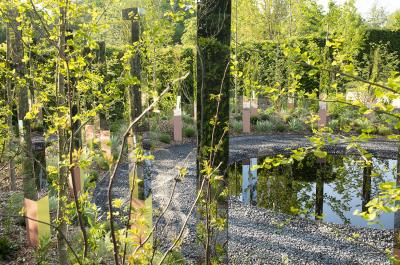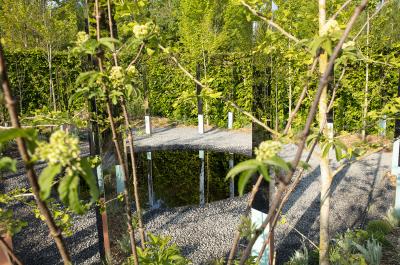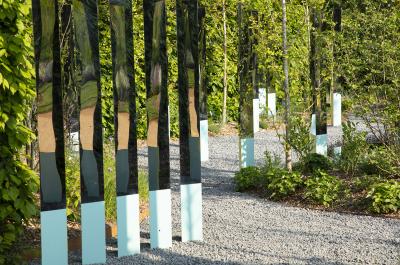06. Le jardin de la réciprocité
published at 31/01/2022
PRIZE FOR DESIGN
Awarded on the 22nd of June 2022 by a jury of professionals renowned in the world of garden art
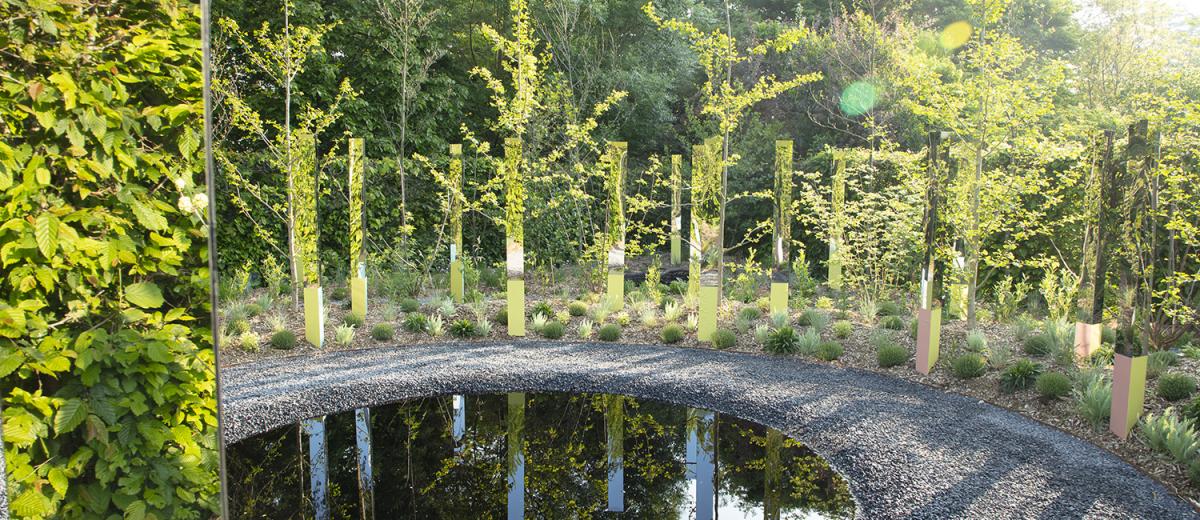
At a time when the human race is acting on nature to the point of becoming its greatest threat, the Jardin de la Réciprocité (Garden of Reciprocity) reminds us that humans cannot exist without it. The connection between nature and humankind is a relationship of mutual dependence. It has to be reconsidered if we are to rebalance the life cycle here on Planet Earth.
Through mirrors set up as totems and a scattering of water points, the Jardin de la Réciprocité invites visitors to give thought to the relationship between nature and humanity. At the entrance to the garden, two rows of mirrors face each other, reflecting the images of those getting ready to chance their arm. Behind this “Portal of Reflection”, between separation and enchantment, the “Forest of Symbiosis” reaches out. Designed as an agroforest meeting essential needs, it is largely composed of medicinal and sacred plants, some of them on the brink of extinction. The various species were chosen for their resilience, despite cultural and geographical borders, and include rowan, Italian poplar, gingko, elderberry and barley.
The “Circle of Reciprocity” lies at the heart of the garden. It takes the form of a pool surrounded by mirror totems providing partial reflections of each visitor, fragmented in the surrounding nature alongside those accompanying them. Here, human beings merge into nature. There’s no longer any question of their being the centre of the world. Where does the human being end? Where does nature begin? In the same landscape…
DESIGNERS
RIOS -Jason SHINODA, Elisa READ PAPPATERRA and Stephanie LIN, landscape architects-
USA
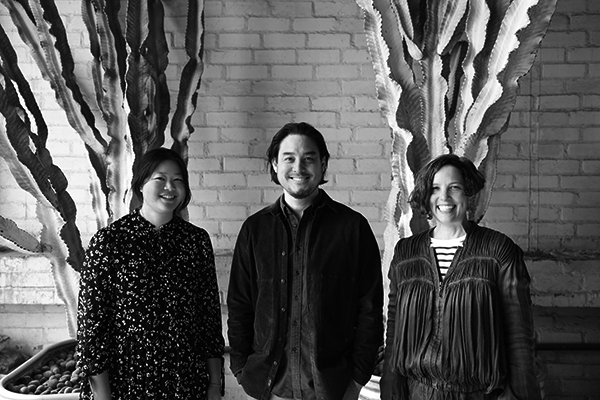
Jason Shinoda, ASLA, PLA, Design Director, Landscape Architecture
Jason Shinoda is a landscape architect and Design Director with the multi-disciplinary design firm RIOS in Los Angeles. His passion for landscape and gardens can be traced to his formative undergraduate years when he studied Japanese gardens in Kyoto and tended to centuries’ old moss gardens while working ata 16th-century Zen temple. His interests expanded to contemporary architecture, particularly in the interface between interior and exterior spaces. After pursuing a master's in landscape architecture at Harvard University’s Graduate School of Design, he began his professional landscape architecture career in London. He worked on several significant landscape urbanism and green infrastructure projects across the UK, Middle East, and India, and gained a passion for ecological planting design. After seven years abroad, he returned to his hometown of Los Angeles, where he has since practiced at RIOS. His work spans a broad range of scales and typologies, from public realm parks and plazas to museums and residential gardens, focusing on storytelling through immersive and amplified experiences. Jason’s work looks for creative solutions to repair urban ecological systems and find adaptations to extreme heat and water scarcity in arid and desiccating environments. He is interested in unearthing a place’s subtle and intrinsic qualities and translating these into well-crafted, rich details in the landscape.
Elisa Read, Horticulture, Fire Ecology Specialist, Landscape Architecture
Elisa Read’s career began in architecture in her home country of the Dominican Republic, where she developed an interest in blurring the edges between indoor and outdoor spaces. She relocated to Los Angeles, California in 2000 for a master’s in architecture, Metropolitan Research + Design, at SCI-Arc. This experience became the platform for her extensive knowledge of flora and fauna. She has been an integral member of RIOS, a multi-disciplinary firm, for over 10 years. Her role as a horticultural specialist allows her to guide the studio with creative thought leadership on sustainability, botany, horticulture, and fire ecology. She has an award-winning body of work in designing and constructing large-scale landscape projects rich in botanical and environmental values. She is well known in the nursery industry and landscape field due to her insatiable thirst for plant knowledge and passion for creating meaningful landscapes. Recently she completed a research grant education project with the Resource Conservation District of the Santa Monica Mountains. The project was part of a coalition of state and local agencies, fire departments, environmental researchers, and nonprofits to create Sustainable Defensible Space. It included a user-friendly website defensiblespace.org compiling best practices for home hardening and sustainable fire-wise landscaping in southern California. Elisa is an avid birder and is working towards visiting all California State Parks and Reserves to study the local flora and fauna.
Stephanie Lin, Project Designer, Landscape Architecture
Stephanie Lin’s background is in landscape ecology, horticulture, and design. Before joining the multi-disciplinary design firm RIOS, she studied ecology at UC Berkeley. She was a farm and garden apprentice at the Center for Agroecology & Sustainable Food Systems at UC Santa Cruz. After a career in residential garden installation and maintenance, she received a master’s in landscape architecture. Her design work spans a variety of scales and types, from residential to institutional. In her work, she seeks to collaboratively create places of refuge, wake up the senses, and connect with memory. She employs landscape design and its elements as a vehicle to make memory connections – with a site’s social history, natural history, or to a personal story. Originally from Los Angeles, she is intimately familiar with California’s local ecosystems and geographies. Balanced with hands-on experience, she enjoys applying relevant research to her design practice. Authored works include the 2019 design research publication, “Towards a Playful City,” which documents the importance of play in urban life. Her most recent published work includes graphic contributions towards “The Wild,” a 2020 booklet exploring adaptive strategies for community resilience in the face of extreme fire risk.

